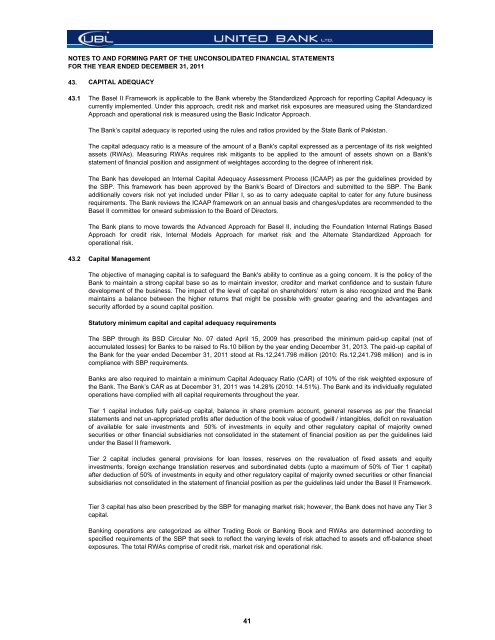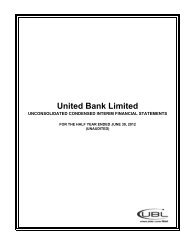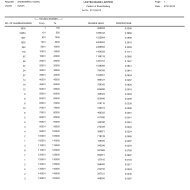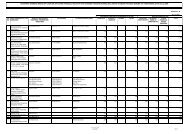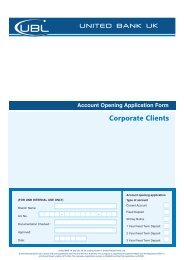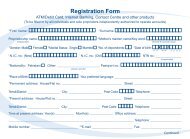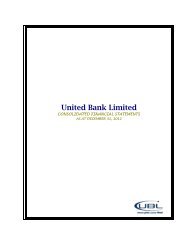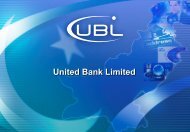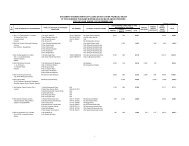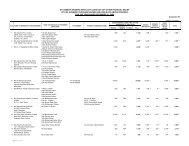UBL Financial Statements - United Bank Limited
UBL Financial Statements - United Bank Limited
UBL Financial Statements - United Bank Limited
Create successful ePaper yourself
Turn your PDF publications into a flip-book with our unique Google optimized e-Paper software.
NOTES TO AND FORMING PART OF THE UNCONSOLIDATED FINANCIAL STATEMENTSFOR THE YEAR ENDED DECEMBER 31, 201143. CAPITAL ADEQUACY43.1The Basel II Framework is applicable to the <strong>Bank</strong> whereby the Standardized Approach for reporting Capital Adequacy iscurrently implemented. Under this approach, credit risk and market risk exposures are measured using the StandardizedApproach and operational risk is measured using the Basic Indicator Approach.The <strong>Bank</strong>’s capital adequacy is reported using the rules and ratios provided by the State <strong>Bank</strong> of Pakistan.The capital adequacy ratio is a measure of the amount of a <strong>Bank</strong>'s capital expressed as a percentage of its risk weightedassets (RWAs). Measuring RWAs requires risk mitigants to be applied to the amount of assets shown on a <strong>Bank</strong>'sstatement of financial position and assignment of weightages according to the degree of inherent risk.The <strong>Bank</strong> has developed an Internal Capital Adequacy Assessment Process (ICAAP) as per the guidelines provided bythe SBP. This framework has been approved by the <strong>Bank</strong>’s Board of Directors and submitted to the SBP. The <strong>Bank</strong>additionally covers risk not yet included under Pillar I, so as to carry adequate capital to cater for any future businessrequirements. The <strong>Bank</strong> reviews the ICAAP framework on an annual basis and changes/updates are recommended to theBasel II committee for onward submission to the Board of Directors.The <strong>Bank</strong> plans to move towards the Advanced Approach for Basel II, including the Foundation Internal Ratings BasedApproach for credit risk, Internal Models Approach for market risk and the Alternate Standardized Approach foroperational risk.43.2 Capital ManagementThe objective of managing capital is to safeguard the <strong>Bank</strong>'s ability to continue as a going concern. It is the policy of the<strong>Bank</strong> to maintain a strong capital base so as to maintain investor, creditor and market confidence and to sustain futuredevelopment of the business. The impact of the level of capital on shareholders’ return is also recognized and the <strong>Bank</strong>maintains a balance between the higher returns that might be possible with greater gearing and the advantages andsecurity afforded by a sound capital position.Statutory minimum capital and capital adequacy requirementsThe SBP through its BSD Circular No. 07 dated April 15, 2009 has prescribed the minimum paid-up capital (net ofaccumulated losses) for <strong>Bank</strong>s to be raised to Rs.10 billion by the year ending December 31, 2013. The paid-up capital ofthe <strong>Bank</strong> for the year ended December 31, 2011 stood at Rs.12,241.798 million (2010: Rs.12,241.798 million) and is incompliance with SBP requirements.<strong>Bank</strong>s are also required to maintain a minimum Capital Adequacy Ratio (CAR) of 10% of the risk weighted exposure ofthe <strong>Bank</strong>. The <strong>Bank</strong>’s CAR as at December 31, 2011 was 14.28% (2010: 14.51%). The <strong>Bank</strong> and its individually regulatedoperations have complied with all capital requirements throughout the year.Tier 1 capital includes fully paid-up capital, balance in share premium account, general reserves as per the financialstatements and net un-appropriated profits after deduction of the book value of goodwill / intangibles, deficit on revaluationof available for sale investments and 50% of investments in equity and other regulatory capital of majority ownedsecurities or other financial subsidiaries not consolidated in the statement of financial position as per the guidelines laidunder the Basel II framework.Tier 2 capital includes general provisions for loan losses, reserves on the revaluation of fixed assets and equityinvestments, foreign exchange translation reserves and subordinated debts (upto a maximum of 50% of Tier 1 capital)after deduction of 50% of investments in equity and other regulatory capital of majority owned securities or other financialsubsidiaries not consolidated in the statement of financial position as per the guidelines laid under the Basel II Framework.Tier 3 capital has also been prescribed by the SBP for managing market risk; however, the <strong>Bank</strong> does not have any Tier 3capital.<strong>Bank</strong>ing operations are categorized as either Trading Book or <strong>Bank</strong>ing Book and RWAs are determined according tospecified requirements of the SBP that seek to reflect the varying levels of risk attached to assets and off-balance sheetexposures. The total RWAs comprise of credit risk, market risk and operational risk.41


